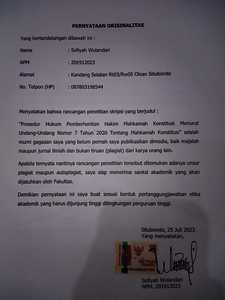Sofiyah, Wulandari and Irwan, Yulianto, S.H., M.H and Muhammad, Yusuf Ibrahim, S.H., M.H. (2023) Prosedur Pemberhentian Hakim Mahkamah Konstitusi Menurut Undang – Undang Nomor 7 Tahun 2020 Tentang Mahkamah Konstitusi. Other thesis, Universitas Abdurachman Saleh situbondo.
|
Text
SKRIPSI SOFIYAH.docx Download (297kB) |
||
|
Text
JURNAL SKRIPSI SOFIYAH.docx Download (28kB) |
||
|
Text
JURNAL TURNITIN SOFIYAH WULANDARI 27%.pdf Download (395kB) |
||
![[img]](http://repository.unars.ac.id/931/8.hassmallThumbnailVersion/WhatsApp%20Image%202024-02-26%20at%2015.10.31.jpeg)
|
Image
WhatsApp Image 2024-02-26 at 15.10.31.jpeg Download (67kB) | Preview |
Abstract
Abstrak ( bhs Indonesia) Sofiyah Wulandari, NPM. 201912023, Prosedur Pemberhentian Hakim Mahkamah Konstitusi Menurut Undang-Undang Nomor 7 Tahun 2020 Tentang Mahkamah Konstitusi. Penelitian yang berjudul Prosedur Pemberhentian Hakim Mahkamah Konstitusi Menurut Undang-Undang Nomor 7 Tahun 2020 Tentang Mahkamah Konstitusi. Penelitian ini dilatarbelakangi oleh pemberhentian Aswanto sebagai salah satu Hakim Konstitusi. Hakim Aswanto diberhentikan oleh Dewan Perwakilan Rakyat (DPR) yang pada saat itu masih sah menjabat sebagai Hakim Konstitusi. DPR memberhentikan hakim Aswanto kerena sering menganulir produk hukum buatan DPR. Hakim merupakan seseorang yang mempunyai fungsi memeriksa dan memutus suatu perkara. Tidak dibenarkan ketika seorang hakim diberhentikan dari profesinya hanya karena memutus atau mengadili sebuah perkara. Secara konsitusi hal tersebut mutlak menjadi tugas dan kewajiban seorang hakim. Bagaimana mungkin seorang hakim terutama Hakim Konstitusi yang menjalankan kewajibannya dapat dipecat tanpa alasan yang mendasar. Hal yang demikian merupakan anomali dan bertentangan dengan aturan yang ada. Penelitian ini bertujuan pertama untuk mengetahui tata cara pemberhentian hakim Mahkamah Konstitusi sesuai dengan Undang-Undang Nomor 7 Tahun 2020 tentang Mahkamah Konstitusi. Kedua untuk menganalisis implikasi hukum terhadap pemberhentian Hakim Konstitusi yang tidak sesuai dengan konstitusi. Aturan tertulis ini secara jelas mengatur syarat-syarat pemberhentian Hakim Konstitusi tepatnya yang tertuang dalam pasal 23. Metode penelitian yang digunakan dalam penulisan skripsi ini menggunakan metode yuridis normatif yang merupakan penelitian kepustakaan. Penelitian ini mengkaji Undang-Undang yang berlaku atau meneliti pustaka yang ada dan yang berkaitan dengan materi yang dibahas. Berdasarkan hasil penelitian ini dapat disimpulkan pertama, bahwa proses dalam pemberhentian hakim Aswanto tidak mempunyai dasar hukum. Melanggar UUD RI 1945 serta tidak sesuai dengan prosedur pemberhentian yang diatur dalam Undang-Undang nomor 7 tahun 2020 tentang Mahkamah Konstitusi. Seharusnya pemberhentian Hakim Konstitusi harus melalui usulan dari Ketua Mahkamah Konstitusi kepada Presiden. Selanjutnya Presiden mengeluarkan surat Keputusan Presiden (Keppres) terkait pemberhentian hakim yang bersangkutan. Kedua, Implikasi hukum terhadap pemberhentian hakim Mahkamah Konstitusi tidak sesuai regulasi yang ada. Hal tersebut tidak mempunyai kepastian hukum sehingga dinyatakan tidak sah dan dapat dibatalkan melalui Pengadilan Tata Usaha Negara (PTUN). Kata Kunci: Prosedur, Pemberhentian, Hakim Konstitusi, Mahkamah Konstitusi. ABSTRACT ( bhs inggris) Sofiyah Wulandari, NPM. 201912023, Termination Procedures of Constitutional Court Judges According to Law No. 7 of 2020 concerning the Constitutional Court. This research is entitled “Termination Procedures of Constitutional Court Judges According to Law No. 7 of 2020 concerning the Constitutional Court.” This research is motivated by the termination of Aswanto as one of the Constitutional Court Judges. Judge Aswanto was dismissed by the House of Representatives (DPR), who was still legally serving as a Constitutional Court Judge at that time. The DPR dismissed Judge Aswanto because he often annulled legal products made by the House of Representatives (DPR). A judge is someone who can examine and decide a case. It is not justified when a judge is dismissed from his profession just because he decides or judges a case. Constitutionally, this is the duty and obligation of a judge. It is provoking on how a judge, especially a Constitutional Court Judge, who is carrying out his/her obligations can be dismissed without a fundamental reason. This issue is considered as an anomaly that does not comply with applicable regulations. This study aims to determine the procedures for dismissing Constitutional Court judges in accordance with Law No. 7 of 2020 concerning the Constitutional Court. Subsequently, this study aims to analyze the legal implications of the termination of Constitutional Court Judges inconsistent with the Constitution. This written rule regulates the conditions for terminating Constitutional Judges, as stated in Article 23. The research method used in writing this thesis is a normative juridical study method, namely library research. This research examines the applicable law or existing literature and related material discussed. Based on the results of this research, it can be concluded first, that the process of terminating Judge Aswanto has no legal basis, violates the 1945 Constitution of the Republic of Indonesia, and does not comply with the termination procedures stipulated in Law No. 7 of 2020 concerning the Constitutional Court. The termination of a Constitutional Judge should go through a proposal from the chief justice of the Constitutional Court to the President. Furthermore, the President issues a Presidential Decree (Keppres) regarding the termination of the judge concerned. Second, The legal implications of the termination of Constitutional Court judges do not comply with applicable regulations. This does not have legal certainty, so it is declared invalid and can be annulled through the State Administrative Court (PTUN). Keywords: Legal procedure, Constitutional Court Judge, DPR, Termination
| Item Type: | Thesis (Other) |
|---|---|
| Subjects: | K Law > K Law (General) |
| Divisions: | Fakultas Hukum > S1 Ilmu Hukum |
| Depositing User: | SOFIYAH WULANDARI |
| Date Deposited: | 26 Feb 2024 08:20 |
| Last Modified: | 26 Feb 2024 08:20 |
| URI: | http://repository.unars.ac.id/id/eprint/931 |
Actions (login required)
 |
View Item |

